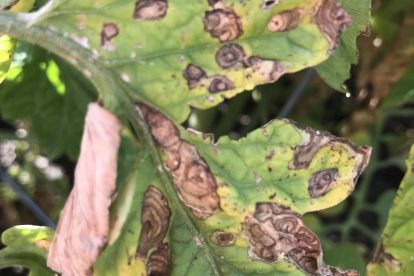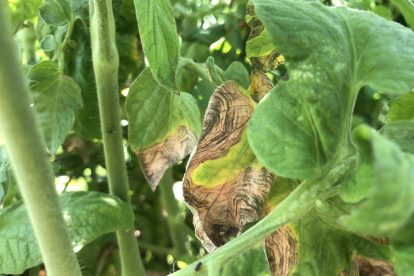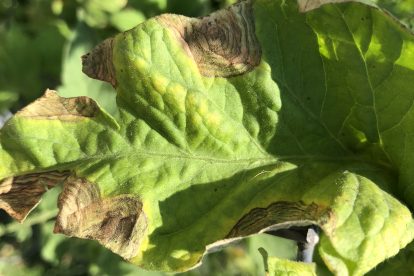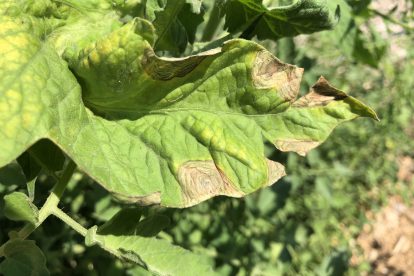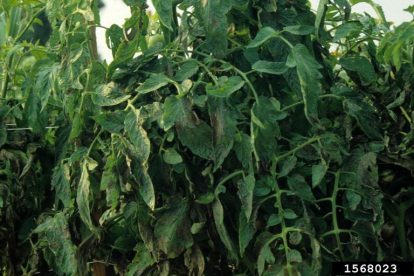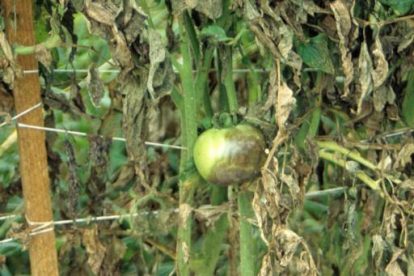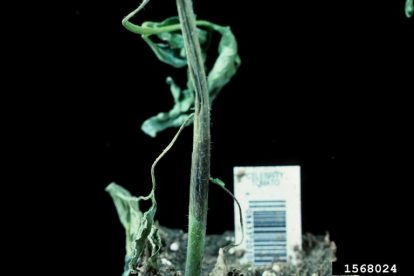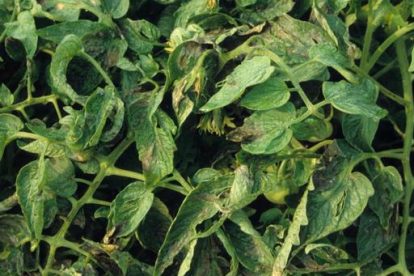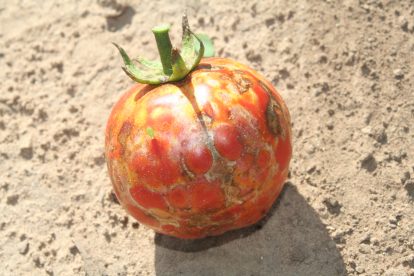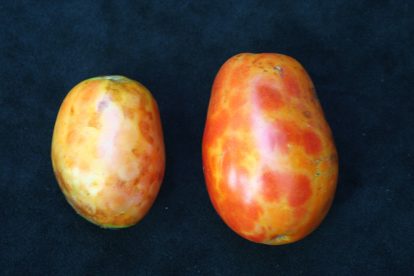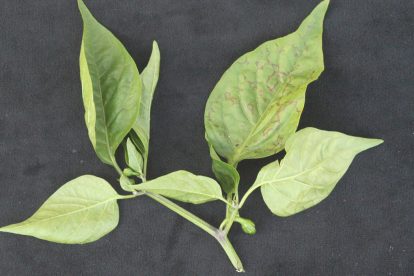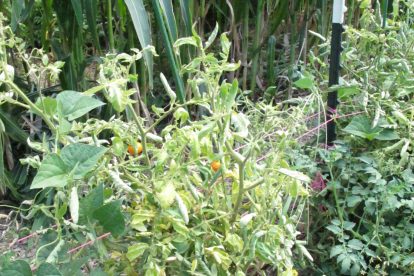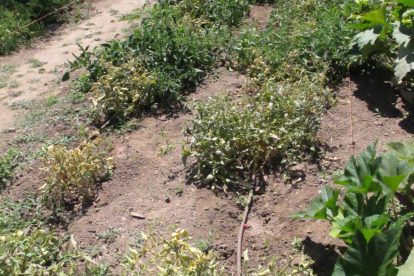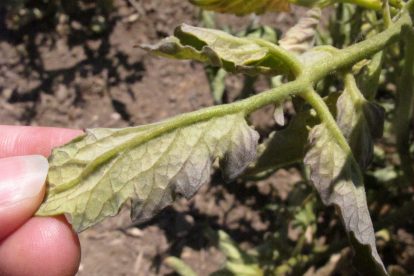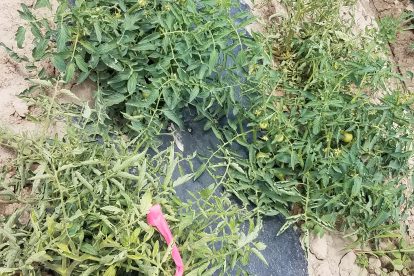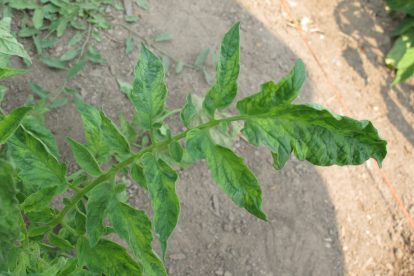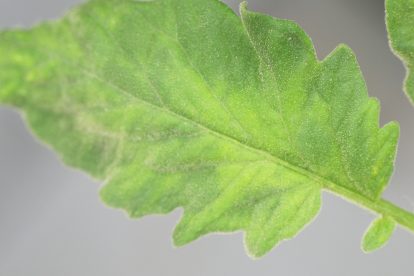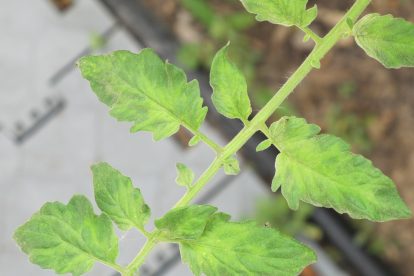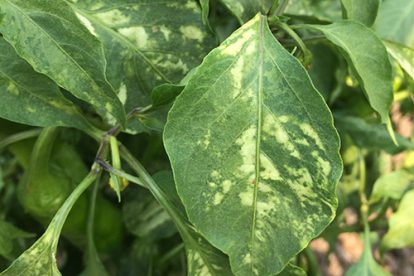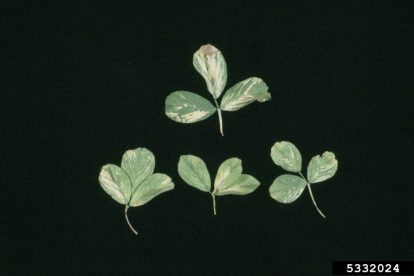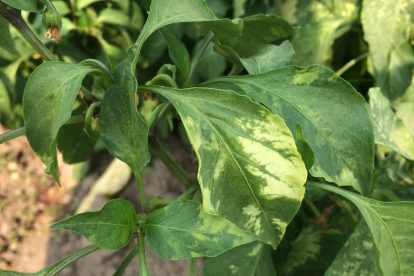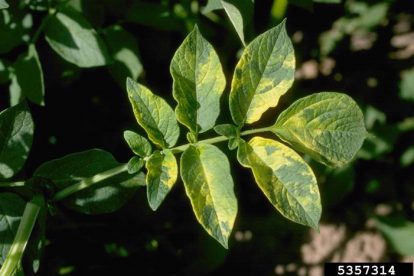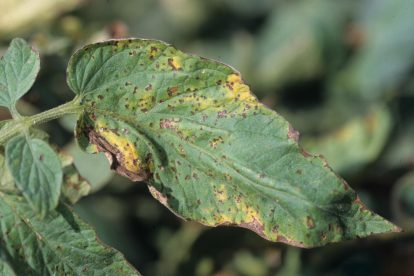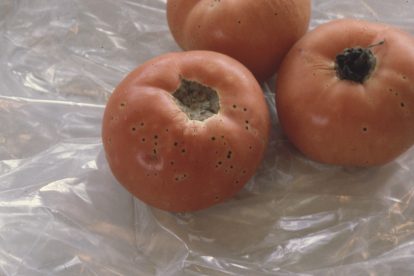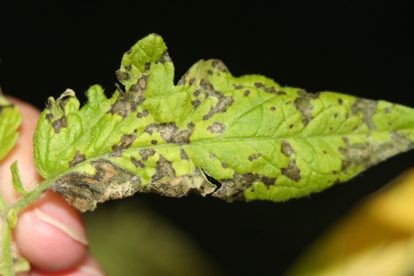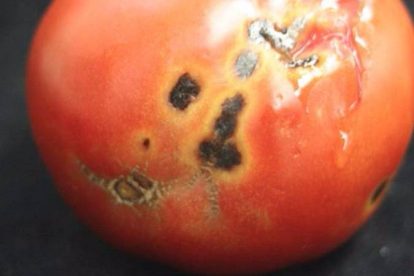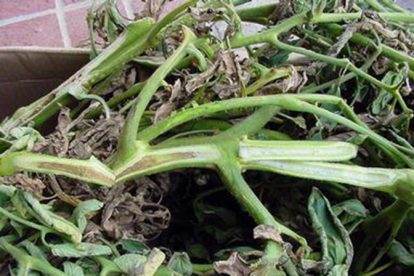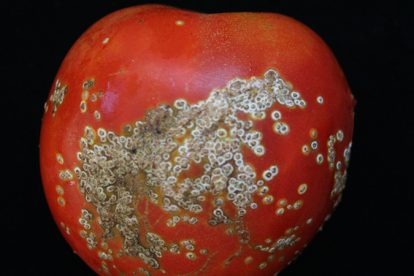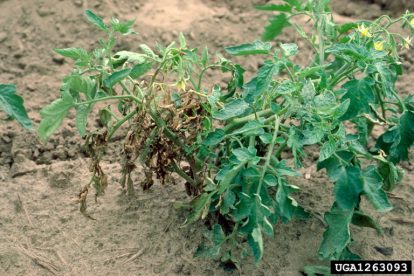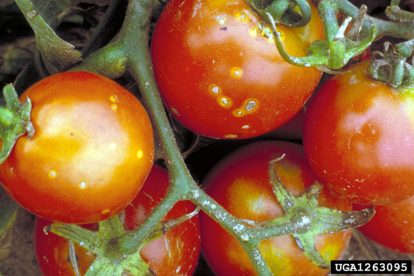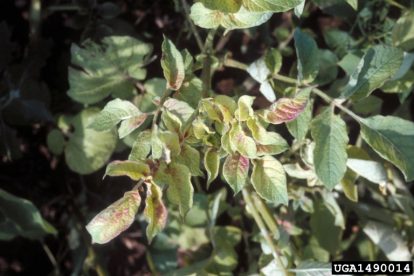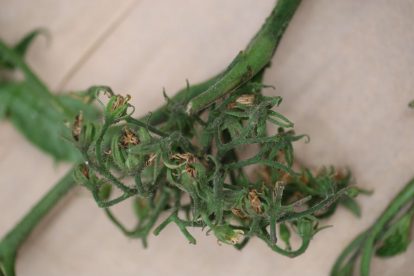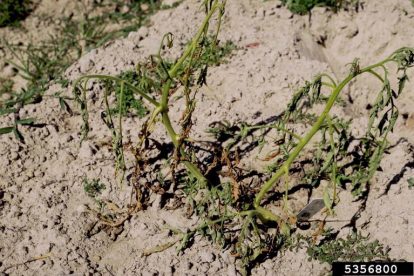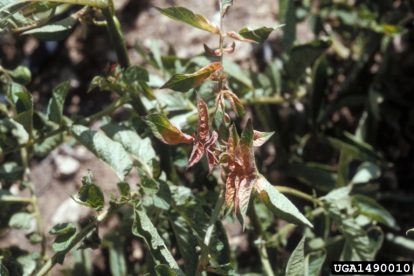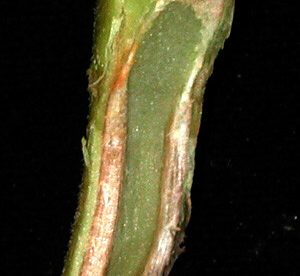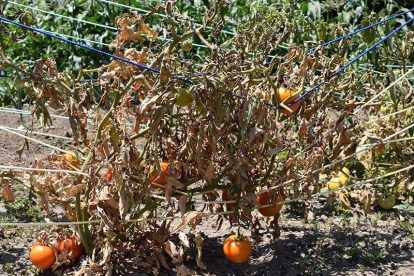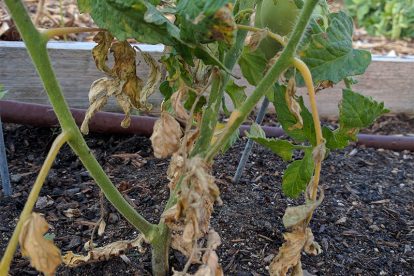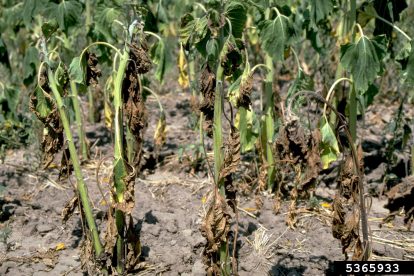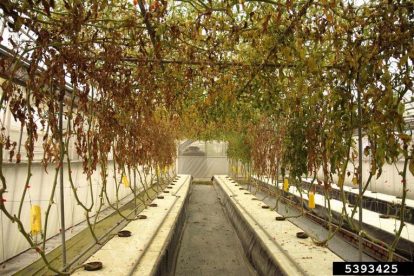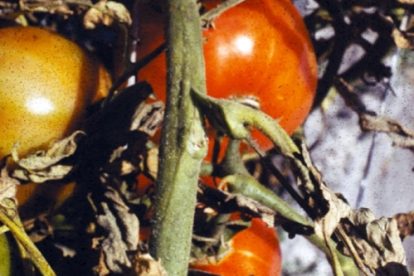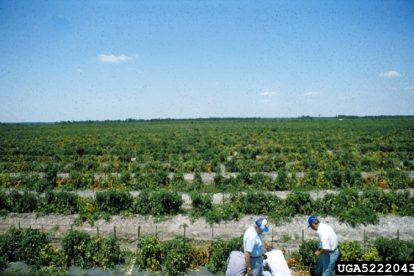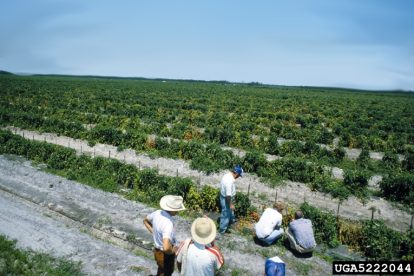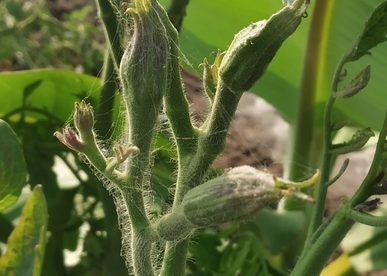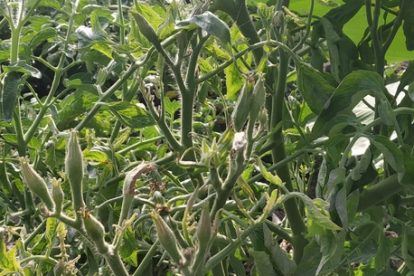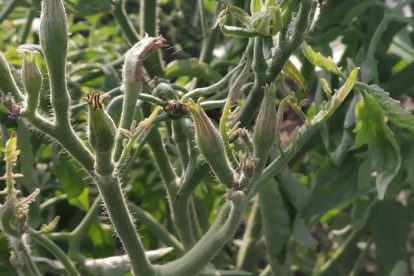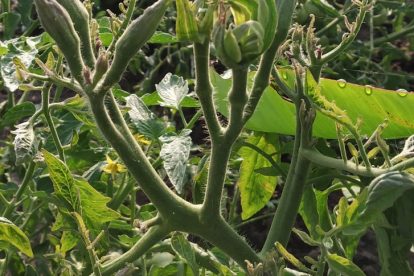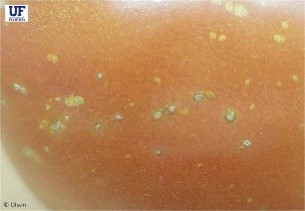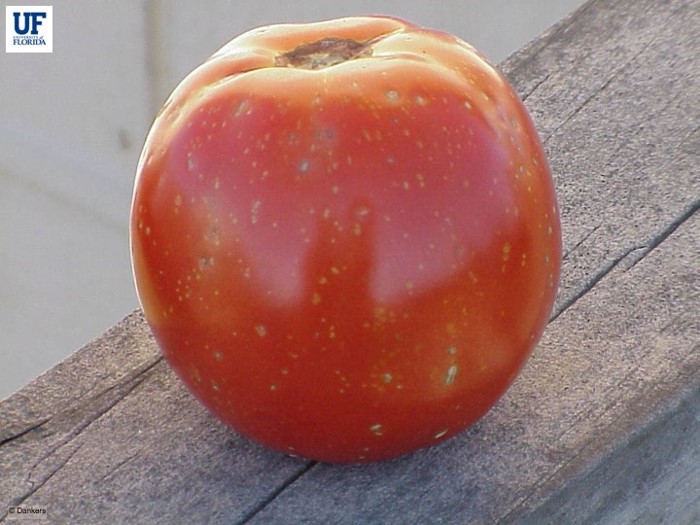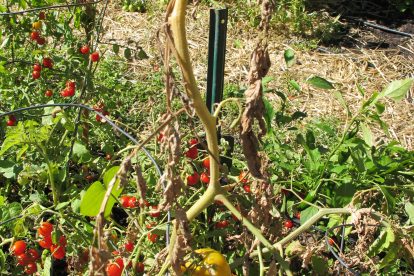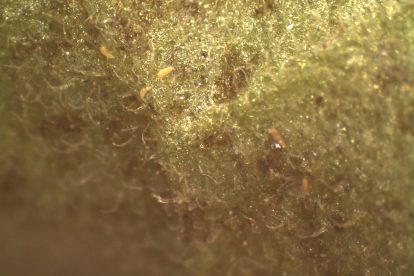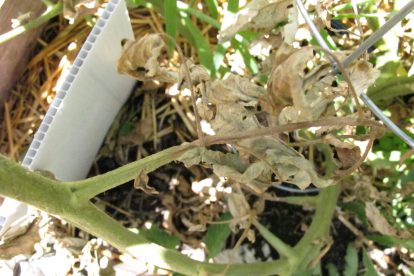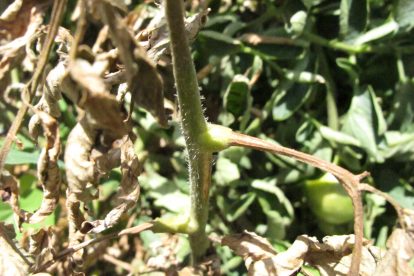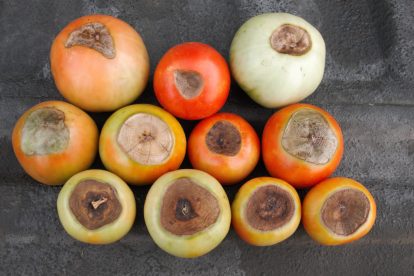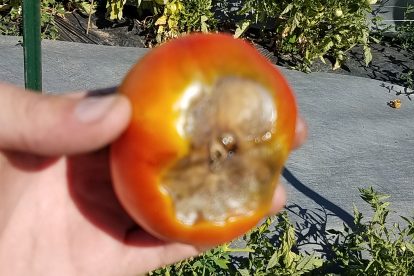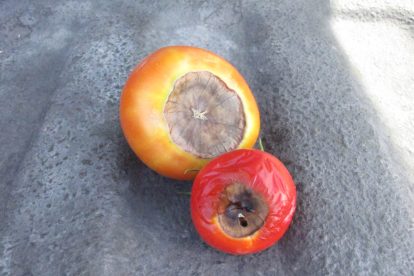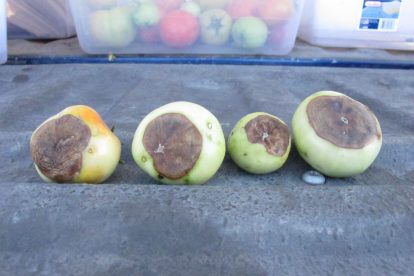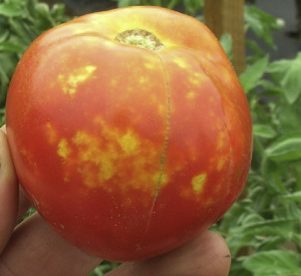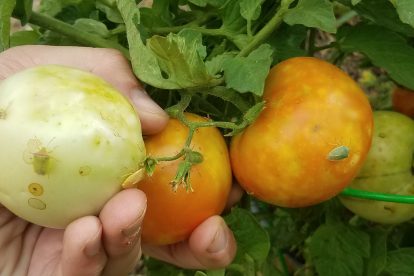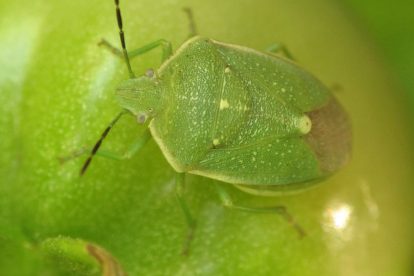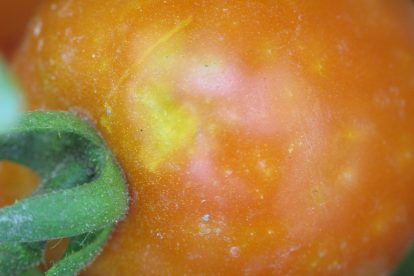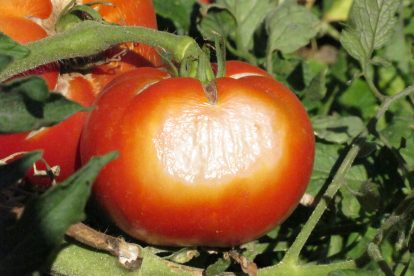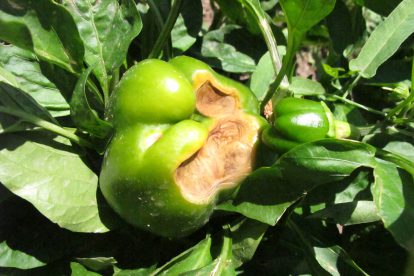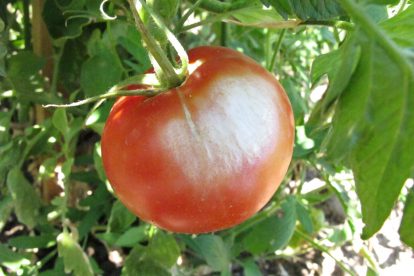Early Blight
Causal Agent/Hosts:
Early blight is caused by the fungus Alternaria solani. It affects tomato, eggplant, potato, but no peppers.
Symptoms:
On the plant foliage, lesions form and concentrate on the older leave closer to the ground. These round, brown spots contain distractive rigs and a yellow margin. In Utah, symptoms typically only occur on the foliage not posing a risk to the fruit.
Disease Cycle:
Infection optimally occurs during periods of rain, heavy dew, or overhead irrigation along with temperatures of 76-86°F. Alternaria solani survives on plant debris within the soil, this is its main inoculum. Spores can be spread by wind or water on the lower foliage to cause a new infection. Germination only takes two hours, and symptoms can be expressed two to three days later.
Management:
- Grow resistant varieties of tomatoes such as Mountain Supreme, Mountain Fresh, Plum Dandy, Mountain Magic, Defiant PhR, Iron Lady, Jasper, Juliet, and Verona. (Look for ‘EB’ on seed labels).
- Rotate soil out of all solanaceous crops for a minimum of two seasons.
- At the end of the season, REMOVE all infected plants and leaves out of the site.
- Click here to view fungicide options for commercial growers
- Click here to view fungicide options for home growers
More Information:
- Early Blight on Tomato and Potato (USU Extension IPM)
- Early Blight (Utah Vegetable Production & Pest Management Guide)
Late Blight
Causal Agent/Hosts:
Late blight is caused by the oomycete Phytophthora infestans (fungus-like eukaryotic microorganism). It affects tomato, potato, and various related weeds of nightshade and bittersweet.
Symptoms:
All the above-ground portions of tomato and potato plants can become infected. It starts as small water-soaked lesions that are grey and blotchy eventually turning black. Severely infects plants will die. On the underside of leaves, the growth of white mold becomes visible on the lesions. Tomato fruits and potato tubers can become infected developing hard, brown, blotchy lesions on the flesh.
Disease Cycle:
Infection occurs during cool, moist weather when temperatures range from 66-72°F. Spores form in the early spring and can be carried for several miles, infections occur on the plant tissue displaying symptoms three days later. Phytophthora infestans survive in infected potato tubers left underground or in cull piles or volunteer Solanaceae plants growing nearby.
Management:
- Start scouting for Late Blight, soon after planting. Early detection is important as spread can be rapid.
- Grow resistant varieties of tomatoes such as Mountain Magic, Defiant PhR, and Lizzano. (Look for ‘LB’ on labels)
- Remove cull piles and plant debris.
- Rotate soil out of all solanaceous crops for a minimum of two seasons.
- Click here to view fungicide options for commercial growers
- Click here to view fungicide options for home growers
More Information:
- Late Blight Tomatoes (Utah Vegetable Production & Pest Management Guide)
- Late Blight Potatoes (Utah Vegetable Production & Pest Management Guide)
Tomato Spotted Wilt Virus
Causal Agent/Hosts:
Tomato Spotted Wilt Virus is a Tospovirus spread by the western flower thrips (Frankliniella occidentalis), onion thrips (Thrips tabaci), or infected plant material. There are over 1,000 known hosts including many common vegetables.
Symptoms:
In tomatoes, symptoms expressed include brown (necrotic) shaped spots on the leaves. On green immature fruit brown spots also occur and be seen as the tomatoes ripen. In peppers, symptoms expressed include chlorotic ringspot patterns.
Disease Cycle:
The Tomato Spotted Wilt Virus is spread by thrips moving from plant to plant depositing the virus as they feed. The symptoms of the virus are expressed 7-10 days after infection.
Management:
- Focus management on controlling thrips populations within the landscape.
- Remove and destroy infected plants, as they can serve as a convenient host for thrips to feed.
- Purchase healthy transplants from nurseries (monitor for brown spots or other symptoms).
- Grow resistant varieties of tomatoes such as Jimbo, Southern Star, Amelia, Crista, Red Defender, Primo Red, Talledga (Look for ‘TSWV’ on the label)
- Manage nearby weeds as they can serve as an alternate host.
More Information:
- Tomato Spotted Wilt Virus of Tomato & Pepper (USU Extension Fact Sheet)
- Tomato Spotted Wilt Virus (Utah Vegetable Production & Pest Management Guide)
Beet Curly Top Virus
Causal Agent/Hosts:
Beet Curly Top Virus is a Curtovirus spread exclusively by the beet leafhopper (Circulifer tenellus). Several plants can be infected by various strains of the virus including common vegetables and weeds.
Symptoms: Infected plants occur randomly due to the sporadic movement of the beet leafhopper as it feeds. Symptoms include small, twisted, downward curled leaves with purple veins, thickened, stiff, and crisps leaves. Fruit ripen prematurely and the overall plant growth is stunted.
Disease Cycle:
Beet leafhoppers acquire the virus when feeding on infected weeds or other plants and transmit it when feeding. The virus can also be spread through potato seed pieces.
Management:
- The Beet Curly Top Virus is widespread and problematic across Utah, especially in commercial tomato production.
- Exclude beet leafhoppers with floating row covers
- Shade plants, as beet leafhoppers prefer to feed in bright areas
- Remove infected plants immediately upon detection
- There are no chemical control options for the virus, insecticides directed at beet leafhoppers are infective due to their high mobility
More Information:
- Beet Curly Top Virus – Tomato (Utah Vegetable Production & Pest Management Guide)
- Curly Top of Tomato (USU Extension Fact Sheet)
- Curly Top Virus on Tomatoes (USU Extension Video)
Tobacco Mosaic Virus, Tomato Mosaic Virus, Pepper Mild Mottle Virus, Tomato Mottle Mosaic Virus
Causal Agent/Hosts:
Tobacco Mosaic Virus (TMV), Tomato Mosaic Virus (ToMV), Pepper Mild Mottle Virus (PMMov), and Tomato Mottle Mosaic Virus (TMoMV) are all viruses in the genus Tobamovirus. They infect hundreds of plants including common vegetable crops. They are primarily spread by seed, grafting, and human handling.
Symptoms:
A wide range of symptoms is expressed in various host plants. These can include abnormal fruit shape, fruit lesions, reduced fruit size, distorted growing points, discoloration, patterns on leaves, and overall dwarfing of a plant.
Disease Cycle:
Infections can occur in various sizes of plant wounds. TMV, ToMV, PMMoV, and TMoMV are seed-borne. The virus can overwinter in seed coats, plant debris, soil, and other perennial hosts.
Management:
- Watch for symptoms throughout the growing season, symptoms can vary depending on the age of the plant, virus strain, genetic background, and environmental conditions.
- Use certified disease-free seed.
- Remove infected plants immediately.
- Search for resistant vegetable varieties (Click here)
More Information:
- Tobacco Mosaic Virus/Tomato Mosaic Virus (USU Extension Information Poster)
- Tobacco Mosaic Virus and Tomato Mosaic Virus (Utah Vegetable Production & Pest Management Guide)
Alfalfa Mosaic Virus
Causal Agent/Hosts:
Alfalfa Mosaic Virus is an Alfamovirus spread by aphids, alfalfa seed, pepper seed, and mechanical activity. There are several host plants including alfalfa, peppers, potatoes, tomatoes, and various weeds.
Symptoms:
Symptoms include yellow mosaic (calico) patterns on the leaves, necrotic phloem tissue, necrotic rings, and spotting on the fruit.
Disease Cycle:
Aphids acquire the virus by feeding on infected plants (typically alfalfa) then spreading it to healthy vegetable crops. The virus can also be spread through seed or mechanical field activity. Alfalfa Mosaic Virus overwinters in perennial hosts.
Management:
- Manage aphid populations within landscapes
- Avoid planting susceptible vegetables near alfalfa or clover
More Information:
Bacterial Speck
Causal Agent/Hosts:
Bacterial Speck is caused by the bacteria Pseudomonas syringae pv. tomato. It exclusively infects tomato plants.
Symptoms:
Symptoms on the leaves are concentrated near margins and predominately on the undersides. They consist of brown to black spots with a yellow halo. Spots on the fruit appear scabby, pinpoint-like, and range in dark colors. The damage does not penetrate the flesh.
Disease Cycle:
The bacteria can be seed-borne and can survive for at least a year in plant debris. Spread between plants occurs by splashing water from overhead irrigation or rain, by using contaminated tools, and by workers brushing along plants. Transplants in greenhouses may carry the bacteria on the surface without disease development. However, once the plants are in the field and environmental conditions are conducive to infection, the disease can develop. Generally, bacterial speck is considered to start under cool, moist conditions ( 63-75 F) but it has been observed in Utah during hot temperatures as well.
Management:
- Delay tomato planting until the cool and wet conditions are over.
- Avoid overhead irrigation
- Only use disease-free seed. When saving seed from plants, do not use seed from infected plants
- Apply preventive copper-based bactericides. Once infection occurs, bactericides will no longer be effective.
- Rotate soil out of all solanaceous crops for a minimum of two seasons.
More Information:
Bacterial Canker
Causal Agent/Hosts:
Bacterial Canker is caused by the bacteria Clavibacter michiganensis subsp. michiganensis. It primarily infects tomatoes and sometimes peppers.
Symptoms:
The primary symptom is wilting. Discoloration can occur in the vascular tissue (visible when cutting open). Secondary symptom includes spots on the leaves and fruit, spots are white with a dark center. The Clavibacter michiganensis subsp. michiganensis infects fruits through infected flowers or the base of the trichomes.
Disease Cycle:
Clavibacter bacteria sbsp. michiganensis is spread on seeds from infected plants, and by using contaminated pruning tools, trays, stakes, and benches. It survives on plant debris for at least two years, and on weeds and volunteer tomatoes. Handling infected plants and then touching healthy plants can spread the bacteria, as does splashing water. The most likely means of spread is during the clipping of transplants.
Management:
- This disease is rare and sporadic in Utah but can be devastating when present.
- Source disease-free seed and transplants.
- Avoid overhead irrigation.
- Rotate soil out of all solanaceous crops for a minimum of three to four seasons.
- Copper-based products are effective in greenhouse transplant production for processing tomato but were ineffective in the field after transplanting.
- Deep plow the soil to bury plant debris
More Information:
Liberibacter
Causal Agent/Hosts:
The bacterium, Candidatus Liberibacter solanacearum (Lso), is primarily known for causing zebra chip on potato, but can also infect pepper, tomato, eggplant, and carrot. Liberibacter was first identified in Utah in 2014 on potato and pepper. In Utah, it is transmitted by the southwest-native insect, potato psyllid (Bacteria cockerelli).
Symptoms:
Symptoms vary depending on plant ae and time on the infection. Leaves of plants getting infected early in the season often show vein greening. The leaf veins are darker green than normal. It is combined with interveinal chlorosis. New leaves are also stunted and cupped. Some infected plants produce more flowers than normal but they are often all aborted. New growth can be stunted and have shortened internodes. No fruit develops after infection, it does it is often deformed.
Disease Cycle:
Potato psyllids acquire Liberibacter by feeding on an infected plant. The bacterium can be passed from adult females to progeny. Depending on the number of potato psyllids feeding, the infection can occur within one to six hours.
Management:
- Monitor for potato psyllids using yellow sticky cards early in the season.
- Once plants are infected with Candidatus Liberibacter solanacearum, there is no control. Focus control on potato psyllids.
- Avoid planting peppers in areas where potato psyllids have been a problem in the past.
More Information:
Verticillium Wilt
Causal Agent/Hosts:
Verticillium wilt is caused by the soil-borne fungus Verticillium dahliae. Host crops include a wide range of vegetables including tomatoes and peppers.
Symptoms:
General symptoms include wilt, chlorosis, red to purple discoloration of leaves or stems, brown discoloration inside vascular tissue, stunted overall growth, foliar necrosis, and premature plant senescence. Reduced seed production or yield may also occur.
Disease Cycle:
Infection occurs when Verticillium dahlia infects the roots of host plants. The fungus overwinters as a survival structure called microsclerotium (hard black ball of fungal tissue).
Management:
- Monitor for symptoms during cooler temperatures (68-74 F). Symptoms may be expressed on one side of the plant, branch, or leaflets.
- Use resistant varieties when available (Look for ‘V’ on seed labels)
- Plant on raised beds for better water drainage
- There are no fungicide options available for Verticillium dahliae
More Information:
Fusarium Wilt
Causal Agent/Hosts:
Fusarium Wilt is caused by special forms of the soil-borne fungus Fusarium oxysporum. Host crops include a wide range of vegetables including tomatoes and peppers.
Symptoms:
General symptoms include wilt, chlorosis, red to purple discoloration of leaves or stems, stunted and/or distorted growth, necrosis, and premature plant senescence. Reduced seed production or yield may occur.
Disease Cycle:
Infection occurs in high soil moisture and temperature (90F) when the fungi infect the roots of host plants. Fusarium oxysporum f. sp. overwinters as resting spores called chlamydospores. The pathogen is highly specific. For example, the forma speciales that infects tomato does not infect pepper or any other vegetable. Each forma speciales is specific to one crop.
Management:
- Use resistant varieties when available (Look for ‘F’ or ‘Fox’ on seed labels)
- Source certified disease-free seed
- Plant on raised beds for better water drainage
- There are no fungicide options available for Fusarium oxysporum f. sp.
More Information:
Tomato Big Bud
Causal Agent/Hosts:
Spread by a phytoplasma transmitted by beet leafhoppers (Circulifer tenellus).
Symptoms:
Large swollen green flower buds, swollen buds do not set fruit, thick stems, and distorted leaves.
More Information:
Tomato Fruit Pox
Symptoms:
Occur when fast-growing plants and fruit is exposed to high temperature. Tomato fruits on the side exposed to the sun are more often affected.
More Information:
- Tomato Fruit Pox (University of Florida Extension)
Russet Mite on Tomato
Causal Agent/Hosts:
Russet mites (Aceria anthocoptes) typically found on tomatoes and sometimes on potato and pepper.
Symptoms:
Bronze discoloration of leaves and stems (“russeting”), Severe infestations will lose their hairs. Fruit will experience “russeting” and cracking and uneven ripening, plants may eventually die.
Management:
- Chemical control options for home growers
- Chemical control options for commercial growers
- Remove alternate weed hosts like nightshade and morning glory
More Information:
Blossom End Rot
Blossom end rot is a physiological disorder due to a shortage of calcium in the young fruit. Moisture imbalances or water stress aggravate the problem by interfering with calcium uptake in the plant.
Symptoms:
The first symptom of the disorder is a slight, water-soaked discoloration on the blossom end (opposite of the stem) of the fruit. As the lesions enlarge, turning leathery and dark brown or black, they often become sunken into the fruit. Although the affected tissue is normally dry, bacteria and fungi may invade the lesion, producing a soft, watery rot. Blossom end rot lesions are frequently invaded by microorganisms and may have a slightly different appearance. They may be weepy, have a fuzz-like growth on them (fungal growth), or they may be cracked.
Management:
- Avoid water stress of fluctuating soil moisture by using infrequent, deep irrigation to keep the soil uniformly moist. Do not allow plants to be water-stressed at night. The best way to evenly maintain the soil moisture is by using organic or plastic mulch to prevent wide fluctuations in soil moisture.
- Avoid over-fertilizing; do not use ammonium-based nitrogen fertilizers.
- To avoid injuring roots, do not hoe or cultivate near plants. Pull weeds next to plants or use plastic mulch.
- Do not overwater, especially in heavy clay soils.
More Information:
Stink Bug Damage on Tomatoes
Symptoms:
Stink bug adults and nymphs have piercing-sucking mouthparts that primarily cause damage to fruiting parts of plants. Damage initially occurs as hard, whitish, callous areas, surrounding a central feeding puncture, later developing into cloudy areas of hard yellow spots. Fruit begins to grow in a distorted manner, with indented areas developing at the feeding sites (catfacing).
Management:
- Plant trap crop barriers around the border of tomatoes or other cash crops.
- Attract and conserve natural enemies.
- Stink bugs are difficult to control with insecticides due to their strong flight capability and tolerance to insecticide residues.
More Information:
Sunscald on Tomatoes
Causal Agent:
intense solar radiation, low humidity, and reflected heat
Symptoms:
Large, light-colored blistered areas develop on the sides of fruits facing the sun. Portions of leaves and stems may also scorch. Commonly seen on plants that have lost foliage due to insect feeding or disease. Affected fruits lose quality and unmarketable.
Management:
- Develop and maintain a good leaf canopy.
- Control insects and disease problems that may lead to defoliation.
- Avoid cutting or breaking off leaves and vines during harvest.
- Trellis crops with heavy fruit loads.
- Construct shade cloth over the crop during the growing season.
- Select varieties noted to retain leaf cover throughout the season, produce more foliage, and/or have a fruit color that reflects more sunlight.

